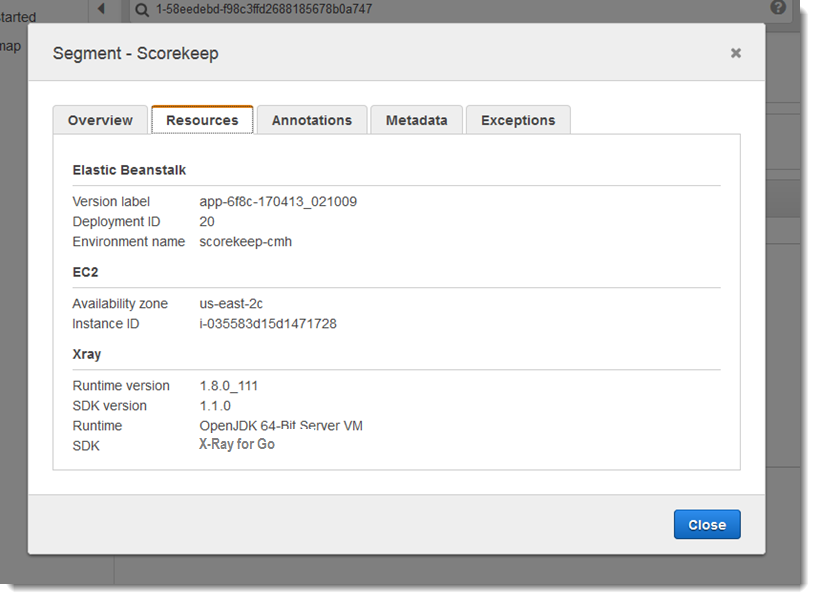Configuring the X-Ray SDK for Go
You can specify the configuration for X-Ray SDK for Go through environment variables, by calling
Configure with a Config object, or by assuming default values. Environment variables
take precedence over Config values, which take precedence over any default value.
Service plugins
Use plugins to record information about the service hosting
your application.
Plugins
Amazon EC2 –
EC2Pluginadds the instance ID, Availability Zone, and the CloudWatch Logs Group.Elastic Beanstalk –
ElasticBeanstalkPluginadds the environment name, version label, and deployment ID.Amazon ECS –
ECSPluginadds the container ID.

To use a plugin, import one of the following packages.
"github.com/aws/aws-xray-sdk-go/awsplugins/ec2"
"github.com/aws/aws-xray-sdk-go/awsplugins/ecs"
"github.com/aws/aws-xray-sdk-go/awsplugins/beanstalk"Each plugin has an explicit Init() function call that loads the plugin.
Example ec2.Init()
import (
"os"
"github.com/aws/aws-xray-sdk-go/awsplugins/ec2"
"github.com/aws/aws-xray-sdk-go/xray"
)
func init() {
// conditionally load plugin
if os.Getenv("ENVIRONMENT") == "production" {
ec2.Init()
}
xray.Configure(xray.Config{
ServiceVersion: "1.2.3",
})
}The SDK also uses plugin settings to set the origin
field on the segment. This indicates the type of AWS resource that runs your application.
When you use multiple plugins, the SDK uses the following resolution order to determine the origin: ElasticBeanstalk > EKS > ECS > EC2.
Sampling rules
The SDK uses the sampling rules you define in the X-Ray console to determine which requests to record. The default rule traces the first request each second, and five percent of any additional requests across all services sending traces to X-Ray. Create additional rules in the X-Ray console to customize the amount of data recorded for each of your applications.
The SDK applies custom rules in the order in which they are defined. If a request matches multiple custom rules, the SDK applies only the first rule.
Note
If the SDK can't reach X-Ray to get sampling rules, it reverts to a default local rule of the first request each second, and five percent of any additional requests per host. This can occur if the host doesn't have permission to call sampling APIs, or can't connect to the X-Ray daemon, which acts as a TCP proxy for API calls made by the SDK.
You can also configure the SDK to load sampling rules from a JSON document. The SDK can use local rules as a backup for cases where X-Ray sampling is unavailable, or use local rules exclusively.
Example sampling-rules.json
{
"version": 2,
"rules": [
{
"description": "Player moves.",
"host": "*",
"http_method": "*",
"url_path": "/api/move/*",
"fixed_target": 0,
"rate": 0.05
}
],
"default": {
"fixed_target": 1,
"rate": 0.1
}
}This example defines one custom rule and a default rule. The custom rule applies a five-percent
sampling rate with no minimum number of requests to trace for paths under /api/move/.
The default rule traces the first request each second and 10 percent of additional requests.
The disadvantage of defining rules locally is that the fixed target is applied by each instance of the recorder independently, instead of being managed by the X-Ray service. As you deploy more hosts, the fixed rate is multiplied, making it harder to control the amount of data recorded.
On AWS Lambda, you cannot modify the sampling rate. If your function is called by an instrumented service, calls that generated requests that were sampled by that service will be recorded by Lambda. If active tracing is enabled and no tracing header is present, Lambda makes the sampling decision.
To provide backup rules, point to the local
sampling JSON file by using NewCentralizedStrategyWithFilePath.
Example main.go – Local sampling rule
s, _ := sampling.NewCentralizedStrategyWithFilePath("sampling.json") // path to local sampling json
xray.Configure(xray.Config{SamplingStrategy: s})To use only local rules, point to the local sampling JSON file by using
NewLocalizedStrategyFromFilePath.
Example main.go – Disable sampling
s, _ := sampling.NewLocalizedStrategyFromFilePath("sampling.json") // path to local sampling json
xray.Configure(xray.Config{SamplingStrategy: s})Logging
Note
The xray.Config{} fields LogLevel and LogFormat are deprecated
starting with version 1.0.0-rc.10.
X-Ray uses the following interface for logging. The default logger writes to stdout at
LogLevelInfo and above.
type Logger interface {
Log(level LogLevel, msg fmt.Stringer)
}
const (
LogLevelDebug LogLevel = iota + 1
LogLevelInfo
LogLevelWarn
LogLevelError
)Example write to io.Writer
xray.SetLogger(xraylog.NewDefaultLogger(os.Stderr, xraylog.LogLevelError))Environment variables
You can use environment variables to configure the X-Ray SDK for Go. The SDK supports the following variables.
AWS_XRAY_CONTEXT_MISSING– Set toRUNTIME_ERRORto throw exceptions when your instrumented code attempts to record data when no segment is open.Valid Values
-
RUNTIME_ERROR– Throw a runtime exception. -
LOG_ERROR– Log an error and continue (default). -
IGNORE_ERROR– Ignore error and continue.
Errors related to missing segments or subsegments can occur when you attempt to use an instrumented client in startup code that runs when no request is open, or in code that spawns a new thread.
-
-
AWS_XRAY_TRACING_NAME– Set the service name that the SDK uses for segments. AWS_XRAY_DAEMON_ADDRESS– Set the host and port of the X-Ray daemon listener. By default, the SDK sends trace data to127.0.0.1:2000. Use this variable if you have configured the daemon to listen on a different port or if it is running on a different host.
Environment variables override equivalent values set in code.
Using configure
You can also configure the X-Ray SDK for Go using the Configure method. Configure takes
one argument, a Config object, with the following, optional fields.
- DaemonAddr
-
This string specifies the host and port of the X-Ray daemon listener. If not specified, X-Ray uses the value of the
AWS_XRAY_DAEMON_ADDRESSenvironment variable. If that value is not set, it uses "127.0.0.1:2000". - ServiceVersion
-
This string specifies the version of the service. If not specified, X-Ray uses the empty string ("").
- SamplingStrategy
-
This
SamplingStrategyobject specifies which of your application calls are traced. If not specified, X-Ray uses aLocalizedSamplingStrategy, which takes the strategy as defined inxray/resources/DefaultSamplingRules.json. - StreamingStrategy
-
This
StreamingStrategyobject specifies whether to stream a segment when RequiresStreaming returns true. If not specified, X-Ray uses aDefaultStreamingStrategythat streams a sampled segment if the number of subsegments is greater than 20. - ExceptionFormattingStrategy
-
This
ExceptionFormattingStrategyobject specifies how you want to handle various exceptions. If not specified, X-Ray uses aDefaultExceptionFormattingStrategywith anXrayErrorof typeerror, the error message, and stack trace.